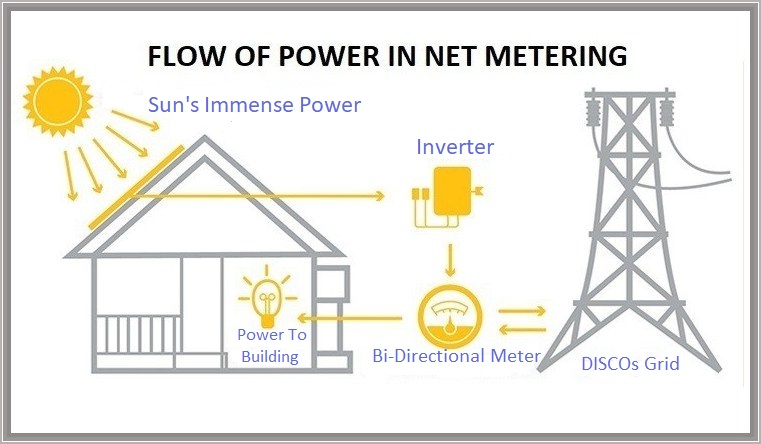Net Metering (alternative energy-generation system ):– Understanding of Renewable Energy
Net Metering is a mechanism that credits solar energy to the National Grid. In other words, arrangements in which individuals and businesses connect their renewable energy system to the electrical Grid. The source of the renewable energy system may be either Solar, Wind or Hyderal (turbines).
In net Metering, consumers generate electricity and sell any extra electricity to the Grid. The idea of net Metering gained popularity because adoption of its self-renewable energy sources.
How Net Metering works:-
- Bi-directional meters will be installed to record the difference between the electricity imported or exported from the Grid. However, if a customer generates more electricity than they consume through methods such as solar or wind, they will receive credits. These credits can be offset against future electricity bills or converted into a payment from the company.
- The distribution company may install a unidirectional meter for consumers/businesses, Which is used for recording energy you purchase from the Distribution company and sell to a distribution company.

The customer received the bills Mepco, Fesco, Iseco, Gepco, and Qesco from the Distribution company, which shows the Export of power into the Grid Conversely, and the energy imported from the Grid. Therefore, the distribution company will be responsible for paying in case of its net Export of energy, shown in the net metering bill.
Benefits and Drawbacks of Net Metering:-
There are countless benefits, but some of them are –
- Financial savings / Control over Electricity bills: Net Metering enables individuals or businesses to generate renewable energy, reducing electricity bills. In other words, saving for finance.
- Energy Independence: this mechanism enables individuals or businesses to become independent by generating renewable electricity. Which reduces the dependency on electricity on the National Grid.
- Environmental benefits: Using alternative power-generating systems reduces air pollution and the emission of greenhouse gasses. On the other hand, generates clean electricity without fuel combustion, which improves the air quality index.
On the other hand, Net Metering has some drawbacks as well.
- Grid management: There are many challenges to deploying Large-scale net metering that can pose challenges for grid management. Variations in electricity generation can be uncertain, which requires additional grid infrastructure. This addition requires an additional Grid for a smooth supply of electricity.
- Net metering complexity in Policies: Net metering policies can be complex and vary between different jurisdictions. The rules and policies may change over time, creating uncertainty and complicating decision-making processes for individuals and businesses.
- The challenge in Integration: The technical challenge may come when integrating a large amount of electricity into the Grid. Such challenges are power quality, voltage regulation, and stability of the Grid. Therefore, net Metering may require additional investments for installation.
Procedure & Requirements to Apply for Net Metering:-
To install Net Metering in Pakistan, follow the procedure/rules issued by NEPRA.
- One can check the eligibility of the applicant according to the NEPRA rules. Individuals/Business Should Present/apply all required application documents to the DISCO office.
- After verifying the documents through the receipt, the DISCO will notify the applicant once the application is completed. This whole process may take a week or ten working days depending upon the schedule of the DISCOs office.
- In case of any in-compliance in an application, within seven days allowed to resubmit the application after issuing notice from the Distributor office.
- After completing the required application, DISCOs will go for a preliminary review which will take 20 working days. In case of failure, the company will be intimate with the reason and reject the application.
- If the DISCO is satisfied with the review, then an Agreement is signed between the Customer/Business and DG within ten working days.
- The applicant and DISCO will dispatch the Agreement to NEPRA to issue a power generation license in 7 working days after the agreement.
- Connection charge estimate (CCE) maintained by the DISCO and the customer. The customer should deposit the said amount in the designated bank and inform it to the DISCO.
The installation must fulfill the following requirements:
- The Grid should install the net metering system because it works with a Grid-tie/Hybrid system.
- Three Phase meter is the requirement to apply for net Metering.
- The sanctioned load should be less than the capacity of the system. If the system capacity is 3KW, the sanctioned load should not exceed 2KW.
Electricity Flow & Bill Calculation :
In net Metering, there are Peak hours of the day in which the cost of electricity units is more than the rest of the day. These hours are usually from 5 PM TO 10 PM, depending on the season. On the other hand, OFF-Peak hours electricity costs less than Peak hours for the whole day.
- These units are Imported from the Grid Station to the home to fulfil electricity for usage.
- These units are Exported to the Grid station by the Solar system owner/ business.
| Billing Calculation of Net Metering | ||
| Peak Hours Bill — OFF Peak Hours = Net Bill |
Let’s calculate the supposed value for Peak hours and Off-peak hours as follows:
| Peak Hours Bill | 1800 |
| OFF-Peak Hours Bill | 2550 |
| Net Bill | – 750 |
The Negative (-Ve) value in the amount shows that the value is adjustable to the customer in the next bill or payable as per agreement with DISCO. If the value becomes positive (+VE), indicating that the peak hours bill exceeds the off-peak hours bill, the consumer must pay that bill amount. The utility company divides the whole year into four quarters based on the Peak Hours and changes them every three months. After the completion of the quarter, if the bill amount is negative, then two options are available.
- Adjust in the Next Quarter
- Cash-out amount of electricity